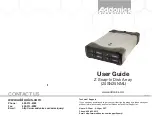
1
1 Overview
The disk array system uses groups of inexpensive
disks to provide flexibility when balancing data avail-
ability, access rate, and capacity management needs.
High data availability is achieved by using the fault
tolerance features of RAID (Redundant Array of Inex-
pensive Disks); hot spare disks with automatic on-line
rebuild; hot swap disks, and power supplies; indepen-
dent ATA disk controllers; and dual host controllers.
Our confidence in the disk array system is backed by a
three year warranty.
A high data access rate is achieved by combining the
individual data rates of ATA disks in a RAID configu-
ration. ATA disks lack some of the features of SCSI
disks but are just as fast when used with a high perfor-
mance RAID controller. In the disk array system,
RAID is controlled by a high performance CPU,
which transfers data through dual host interfaces at the
maximum possible rate.
Flexible data capacity management is achieved with on-line RAID expansion, RAID capacity
division into slices, and multiple logical RAIDs. Management is performed through front panel
or RS-232 interfaces.
Features
The main features of the disk array system are listed as follows. Refer to the specifications table
on page 29 for more detailed information.
• Operating system independent
• Up to eight JBOD, RAID 0, 1, 3, 5, 0+1, 30, or 50 array groups
• On-line expansion and RAID level migration
• Allows division of array groups into slices, each mapped to a LUN
• Hot spare disk and automatic on-line rebuild
• Up to 8 hot swap ATA disks on independent channels for up to 2 TB (terabytes) capacity
• Two hot swap power supplies – if one fails, the others take over without interruption
• Fast 64-bit RISC CPU based RAID controller with up to 1 GB of cache in an SO-DIMM
• Ultra SCSI (easyRAID S8-U4TT) or fibre channel (easyRAID S8-F2TT) host interfaces
• Audible alarm, disk tray LED, and LCD panel failure indicators
• Configuration via the front panel or RS-232 interfaces
• Real-time clock
ESC
Enter










































